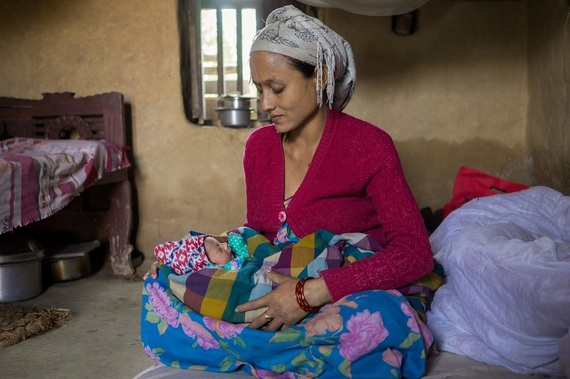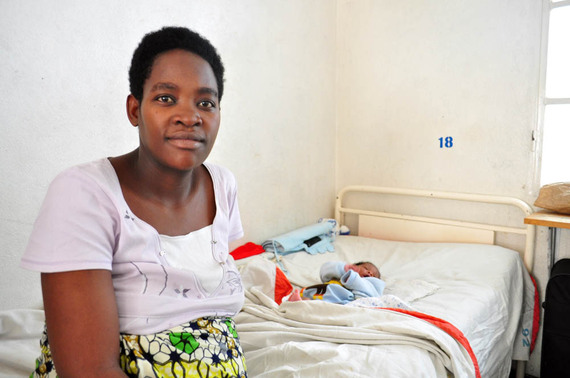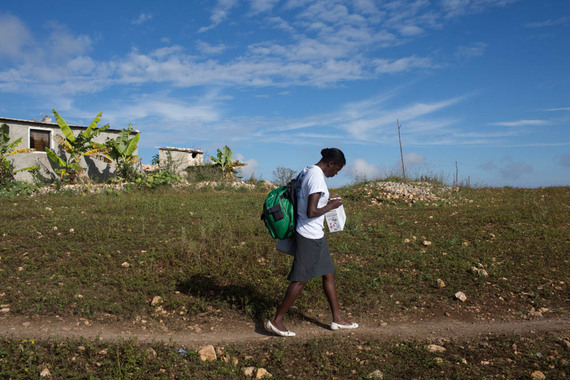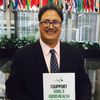
Laxmi of Binauna, Nepal, recently gave birth to her third child. Health workers, many of whom are women in Nepal, provide essential services and counseling to women in rural areas. Photo credit: Thomas Cristofoletti/USAID.
Co-authored by Elizabeth Fox, USAID Deputy Maternal and Child Survival Coordinator, Director of the Office of Health, Infectious Diseases, and Nutrition.
From May 16-19, international leaders from all sectors of society convene in Copenhagen for the Women Deliver 2016 Conference.
There, they will discuss how we as a global community can implement the Sustainable Development Goals (SDGs) -- a set of seventeen targets to coordinate global efforts in international development through 2030 -- so that they are especially meaningful for women and girls, with a particular emphasis on women's and girls' health and rights.
The SDGs count for women and girls -- and women and girls count for the SDGs. Gender equality is included explicitly in SDG 5, and investing in women and girls furthers our progress towards all of the global goals.
When we start with women's health in particular, we empower women to achieve their full potential and to transform the communities around them.
Women's Health and Rights
Healthy mothers are the pillars of healthy families.
At the U.S. Agency for International Development (USAID), our efforts in maternal and child health are improving health outcomes for mothers and their children in countries around the world. A mother's death has devastating effects on the survival of her children, the economic stability of her family, and the productivity of her community. An infant whose mother has died is eight times more likely to die in the first year of life than the infant of a mother who survives.
When women are empowered to lead healthy lives, they and their children, families, and communities prosper. Women can empower themselves and each other, and they are also empowered by the men, partners, and fathers around them. Programs that promote gender equity, couple communication, and joint decision-making result in healthier families and more resilient communities.

At the USAID-supported Nemba Hospital in Rwanda, Mukampazimpaka safely gave birth to a new baby boy, not yet named. Giving birth in a health facility that offers high-quality, respectful maternal services can significantly improve health outcomes for women and their newborns. Photo credit: Amy Fowler/USAID.
USAID is working to end preventable child and maternal deaths within a generation, concentrating our efforts in 25 priority countries that account for more than two-thirds of the world's child and maternal deaths and more than 50 percent of the global unmet need for family planning. Since 2008, our efforts have saved the lives of 4.6 million children and 200,000 women. Our 2015 Acting on the Call report details how to reach 38 million women with increased access to health services by 2020.
This goes beyond care for women solely during pregnancy and delivery. Healthy timing and spacing of pregnancy is also vital. Women empowered to make decisions about their reproductive health are better able to protect themselves against maternal death: research has shown that contraceptive use reduced maternal deaths by 44 percent. And a USAID analysis found that if all birth-to-pregnancy intervals were expanded to 3 years, 1.6 million child deaths could be averted annually.
As the world's largest bilateral donor in family planning, USAID supports Family Planning 2020 to enable 120 million more women worldwide to use contraceptives by 2020, a vital step towards achieving global goals in women's health and rights.
Women's Health and the Global Goals
USAID's efforts to end preventable child and maternal mortality have a clear and direct impact on the health of women, children, and their families. Yet when we invest in women's health and rights, we invest in much more than that: we invest in global goals from education to the environment, from peaceful societies to prosperous economies.
When women are able to stay healthy and plan whether, when, and how often they get pregnant, they tend to have fewer children, affording them greater opportunities to seek employment and contribute to household income and assets. They are able to devote more resources to each child, thereby improving health and expanding educational opportunities.
Enabling young women to avoid early pregnancy allows many to attend school longer. If all women in sub-Saharan Africa completed primary school, maternal deaths would decrease by 70 percent, and almost 60 percent fewer girls would become pregnant before age 17 in sub-Saharan Africa and South and West Asia if they all had a secondary education.
Healthier moms with fewer children are then better able to provide educational opportunities for their children -- especially for their daughters, as resources for education are often allocated to boys in situations of extreme poverty.
At the heart of USAID is our mission to end extreme poverty and to promote resilient, democratic societies. With such broad benefits across the board, women's health is one of the smartest investments that we can make.
Women, Girls, and the Road to 2030
The factors that contribute to these global challenges -- extreme poverty, gender inequality, unintended pregnancy, maternal and child death -- are often interrelated and interdependent, sometimes even identical. With universal health care enshrined in the SDGs and embraced ahead of the G7 Summit this year, women and children must be at the heart of national health systems worldwide.

Community health workers, like Ketcia of rural Robin, Haiti, play an invaluable role in providing vulnerable and hard-to-reach populations with essential maternal and child health services. Photo credit: David Rochkind/USAID.
Only through integrated approaches to development, in which women and girls are included, empowered, and consulted every step of the way and men are engaged as part of the solution, can we ensure that we are working with the greatest efficiency and efficacy.
Gender equality, after all, is no finishing touch on the world that we have envisioned for 2030. It helps form the foundation upon which it is built.
When we invest in women and girls, we invest in our collective global vision for the world in 2030 -- a vision for people, planet, peace, and prosperity; a grand convergence in which every woman, child, and man has the opportunity not just to survive, but to thrive.
Visit USAID's virtual exhibition booth for the Women Deliver 2016 Conference.
Follow Dr. Ariel Pablos-Mendez and USAID for Global Health on Twitter and Facebook.
